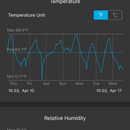Ideal indoor climate conditions during construction?
I am curious, what is the ideal temp and RH on a construction site? When should I expect to see it normalize (mainly RH)? Sorry if this is a stupid question! It seems like there are optimal conditions at various stages of construction.
I set up a couple sensors just for fun and now I can see the past few weeks of data. I know humidity is to be expected, but is there a goal? We have a dehumidifier going in the basement but I’m not sure if they leave it running or if it’s only on while they’re working. Now I’m tempted to get another sensor for the basement. And, of course, one for the attic. Though I might just move around the ones that I have.
Climate zone 7. The house is currently framed and sealed up, partially insulated. Temp peaks at the end of the day, I assume from solar heat gain and the crew working.
I wanted to see what was going on. It seems like sensors/tech is under-utilized in building. So while this is a bit pointless, I see how it could be more useful in other scenarios like if you put sensors inside the wall assembly to monitor performance. Or in an attic, given the prevalence of moisture related attic issues homes seem to have. I understand that you can kind of tell when there is moisture, there will be signs, but I don’t know how many people are doing frequent attic inspections.
I am way too excited about these sensors. They are Govee, the app is great.
Thanks!
GBA Detail Library
A collection of one thousand construction details organized by climate and house part












Replies
Simple put there is just so much moisture in your new construction that your dehumidifier needs to be turn on 24-7 as soon as the building has windows and doors.
Expect the dehumidifier to run constantly until the end of your first heating season and intermittently for another year.
Monitoring the humidity might be entertaining but does not change what is happening. OK maybe it might convince you to buy a second dehumidifier.
Walta
Once you get a roof on, heating in the sun will drive a lot of moisture out of the house.
But I've never heard of anyone holding up construction while they wait for the indoor climate to improve.
And now I must search for the most efficient dehumidifier, they use so much electricity! I didn’t realize we would need to use it once moving in. I think it’ll be interesting to keep an eye on, for instance when it comes to installing the wood flooring (engineered) or millwork/cabinetry. I imagine hitting 70% RH is not ideal.
The attic will be more interesting, I’m not sure the ventilation is adequate yet so we might end up adding gable vents. It’s currently got ridge venting and they vented up behind the steel siding into the attic, my builder has not shared the air flow calcs though and it is to be seen if this provides enough intake air since it has to come up from the bottom of the siding through the metal insect mesh/rain screen.
Is there a certain % you would think an attic should not go above, on average? I like the idea of it being <50% RH but I’m not sure how realistic that is. It seems like if we’re seeing frequent RH of like 70% up there we will need to add gable vents though. It’s a bit late to test now as it’s spring here. Is it reasonable to ask my GC to come back to install gable vents if the moisture level seems too high next winter?
Izzza,
Our code here in BC precludes connecting the wall cavity with the roof above for fire spread reasons.
Apart from meeting the required volume of roof ventilation air, the ratio of inlets to outlets is important too. Having equal (or preferably less) outlet volume keeps the attic depressurized, which helps minimize air-leakage from the house below. So adding gable vents may not be a good idea.
Trust me, I’m also skeptical. I posted previously about it. Seemed to be ok as far as venting behind the cladding. The issue is that we have no overhangs (don’t judge, it was the architect). And combined with black steel siding and roofing, the concern was inward solar vapor drive in the walls, I think. The bottom was vented but there was nowhere for a top vent without overhang without creating a huge risk for leaking. So they figured a way to direct into the attic and delete the gable vents which were in the design.
Why do you say the gable vents might be bad? Isn’t it the opposite? I thought ideally there should be a bit more intake air than exhaust in order to keep attic slightly pressurized. The gable vents would be low, should have added, so they would serve as intake and the ridge venting would remain as exhaust. Adding low gable vents would add additional intake air, I’m under the impression this would help in preventing depressurization. Don’t we want it slightly positive rather than sucking from the conditioned space below?
Izzza,
I assumed the gable vents would be located close to the peak as that is where they typically are . If they are near the floor of the attic then yes they would no doubt be beneficial.
Izzza,
The indoor conditions will not stabilize until the house is air-sealed, insulated and conditioned. Even then you may experience high humidity until the moisture in the construction materials has dissipated. The only thing I can think of that may affect is wood or wood-based flooring, which should be acclimatized to the predicted humidity levels that house will be maintained at once occupied.
Malcolm --
While it would probably be better to acclimate to the predicted humidity levels, it seems the instructions always say to acclimate to the current conditions.
My observation is that in new construction all wood is installed as tight as possible with the expectation that it will always shrink as the house dries out.
I assume we will want the RH to be about 40-50 once we move in, depending on the season. I know drier is better but I can’t handle it for cosmetic reasons 🙃
When we install flooring ~ late June, it might be tough to have it at that level for the wood to acclimatize properly. Should we just go crazy with dehumidification regardless of the energy cost and practicality of doing so?
Izzza,
I think acclimatizing wood flooring to the conditions found in the house under construction is the wrong approach. You want the flooring to be the correct moisture level for the average RH the house will experience throughout the year when occupied. That often means dehumidifying the flooring in a contained area just before installation - the goal being a specific moisture content largely unrelated to the conditions in the house at installation.
This article describes what is in play and provides a chart.
https://www.finehomebuilding.com/2022/05/03/how-to-acclimate-a-wood-floor-correctly
Thanks! I am sure my GC knows, but asking questions is very expensive because I’m paying for hourly management. And I have infinite questions, but finite money. I’m so grateful for everyone sharing so much info on this site!
Interesting that it can take months(!) to acclimatize the wood in boxes. I’ll be sure to check how they want to do it. Seems tricky if we’re painting in June right before doing the flooring. I look forward to seeing how this works, logistically.
Check out this thread:
https://www.greenbuildingadvisor.com/question/wood-air-and-water-the-interplay-of-temperature-humidity-and-wood-moisture-content
Short answer is that equilibrium moisture content (EMC) is a function of both temperature and humidity. EMC can easily change by 50% in a single day. So it's kind of a fool's game to try and target a specific EMC. You just don't want to install wood that is outside of the range your house will normally experience.
Have you read this article?
https://www.greenbuildingadvisor.com/article/all-about-attic-venting
“The standard code formula requires 1 square foot of net free ventilation area for every 300 square feet of attic floor area, assuming that half of the ventilation openings are located in the lower half of the attic (generally at the soffit) and half near or at the ridge. If a roof has only soffit vents and no ridge vents, most codes require 1 square foot of net free ventilation area for every 150 square feet of attic floor area.”
Walta
Yes, and there was a very long winded thread about this: https://www.greenbuildingadvisor.com/question/attic-ventilation-connected-to-rain-screen-with-no-overhang-roof-design-in-a-cold-climate
If you dare scroll through you will see at one point I posted the construction detail drawing.